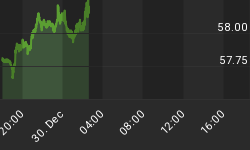There is a sense of panic amongst the bulls. My goodness the SP500 hasn't gone anywhere in 9 weeks, and the economic data isn't look too good. Many of the bulls must be wandering to themselves: "Ooops! I fell for it again". The market appears to be topping out after we were all told that this is one of those can't miss you better jump on board now the train is leaving the station moments that you will certainly regret. Fooled again. Ahh, take heart the market is only at the bottom of its 9 week price range, and why worry about a little 53 point drop in the SP500 from its recent near term high to the current close especially since the market moved up nearly 350 SP500 points in the prior 4 months to get to those highs. I guess the problem is most of the recent converts were not around in October and only decided to warm up to the market once they were told it is a sure thing.
If there is one good thing about utilizing investor sentiment in my investment process it is that it creates a discipline of buying low and selling high. There is nothing magical about it. You are taking on risk when others are shedding it, and you are offloading risk when others are taking it on as they have determined that the all clear has been sounded. 80% of the time it usually pays to be a contrary and go against the grain. The other 20% of the time it pays to invest with the bulls, but this time doesn't appear to be one of those times.
In reality, the market is just at the bottom of a price range that it has seen several times over the past couple of months. So what's the big deal? As stated last week, I believe this is a market top, and as I stated several weeks prior to that, you are best to sell into any kind of strength. Even though little has happened that we haven't seen over the past couple of weeks, somehow I get the feeling that the bulls aren't feeling too good right now.
As stated last week, the 2011 market top took over 6 months to develop. The SP500 traveled in a narrow 75 point range before dropping 20% over a 4 week period. The current price range is 65 SP500 points, and the current market environment has many similarities to 2011. The top can best be described as a period of discussion. Is the economy sputtering? Will the European contagion effect the US economy? Will the fiscal cliff be realized? And of course, the #1 topic of discussion and the only one that matters: will there be QE3? This all sounds familiar.
This is a range bound market. For those investors who want to act like traders, this means to sell at or near the top of the range and buy near the lows. For those investors, who want to act like investors, "sell in May" may be an appropriate strategy. There will be better opportunities ahead.
The "Dumb Money" indicator (see figure 1) looks for extremes in the data from 4 different groups of investors who historically have been wrong on the market: 1) Investors Intelligence; 2) MarketVane; 3) American Association of Individual Investors; and 4) the put call ratio. This indicator is now neutral.
Figure 1. "Dumb Money"/ weekly
Figure 2 is a weekly chart of the SP500 with the InsiderScore "entire market" value in the lower panel. From the InsiderScore weekly report: "Insider trading volume began to rise during the latter part of last week as trading windows opened in the wake of the first big batch of earnings reports....sellers set the pace (outnumbering buyers by a 5:2 ratio)."
Figure 2. InsiderScore "Entire Market" value/ weekly
Figure 3 is a weekly chart of the SP500. The indicator in the lower panel measures all the assets in the Rydex bullish oriented equity funds divided by the sum of assets in the bullish oriented equity funds plus the assets in the bearish oriented equity funds. When the indicator is green, the value is low and there is fear in the market; this is where market bottoms are forged. When the indicator is red, there is complacency in the market. There are too many bulls and this is when market advances stall. Currently, the value of the indicator is 67.91%. Values less than 50% are associated with market bottoms. Values greater than 58% are associated with market tops. It should be noted that the market topped out in 2011 with this indicator between 70% and 71%.
Figure 3. Rydex Total Bull v. Total Bear/ weekly
TheTechnicalTake offers a FREE e-newsletter: HERE
















